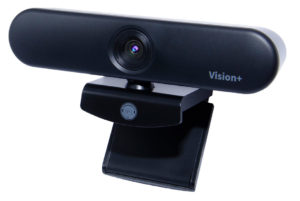The video-first collaboration landscape is finally here.
The COVID-19 pandemic, lockdowns, and a growing need for immersive interactions between team members means more employees are switching their cameras on for meetings. After all, it’s the best way to get that face-to-face human interaction we all crave.
Even when companies can welcome their employees back into the office, the evidence suggests that the workforce will be a hybrid one, with remote workers still playing a big role. The demand for anywhere work combined with the benefits of video (reduced travel and costs) means this kind of conferencing isn’t going anywhere.
With that in mind, is it worth updating to a 4K webcam? Or is 4K just overkill?
What is 4K and why do we need it for work environments?
The 4K resolution refers to a digital resolution (horizontal) made up of around 4,000 pixels. In consumer media and TV, the standard for 4K is around 3840 x 2160. 4K webcams are gaining a lot of attention these days in the remote working landscape. However, if you’re the kind of person who only uses your camera for your Teams calls – you probably don’t need 4K.
4K does have it benefits in some situations. Better depth perception, a higher definition image, and more vibrant colour are all great. In an important meeting or a conference room with multiple people, 4K can offer better resolution.
You could also record 4K content for people to stream later with a 4K camera – but that doesn’t mean it’s really necessary.
I recently spoke with James Clarke, the CEO of JPL (a UK Telecoms Company specialising in the manufacture of Headsets and Webcams), as part of my research for this blog, and he made some interesting points. He told me that most people who stream online are using 1080p resolutions anyway. Most monitors and laptops in home and office environments just don’t have the ability to display 4K images without downscaling or distortion anyway.
4K Webcams and the Bandwidth Issue
As James told me in our meeting, one of the biggest problems in actually using a 4K webcam is the bandwidth demand. 4K cameras can use about 23-35MB of bandwidth. That’s more than I get at home – and I have to share my internet with the rest of the family!
Most offices and homes won’t have the sort of bandwidth required to allow for one person to stream content with a 4K webcam – never mind an entire workforce. If various employees were trying to use a 4K camera at once, the result would usually be worse picture quality, problems with sound, and even issues with software too. Ultimately, a good-quality HD camera in 1080p would deliver a better experience.
Imagine an office trying to cope with tens or hundreds of calls with colleagues and customers all in 4K quality. The networks we have today (particularly in the UK) just couldn’t cope with that kind of pressure. Even if they could, with 4K images hogging all the bandwidth – what would that mean to the rest of our connected tools and devices? Would our technology struggle to function?
Let’s Stick With 1080p

4K webcams in a conference room as a special tool for specific occasions might be a good investment. However, the average work-from-home employee just doesn’t need this kind of resolution. JPL still recommends it’s leading 1080p webcams as the ideal solution for many home and office workers. If you’re just having Zoom or Teams calls with colleagues, or connecting over the web with clients, then 1080p is more than enough.
The chances are that even if you could afford the extra bandwidth requirements that a 4K webcam would demand, the person on the other end of the video call wouldn’t be able to handle your stream. You’d be wasting time, resources, and money on an experience that could end up worse for both of you. It doesn’t make sense to put yourself through that just so you can say you have the latest 4K camera.
Despite home office investments becoming their own kind of fashion statement, they’re not really worth the expense. Personally, I think sticking to 1080p is a better option anyway. I look terrible in 4K – and 1080p is much kinder to my blotchy skin.
My advice? Stick to 1080p.







